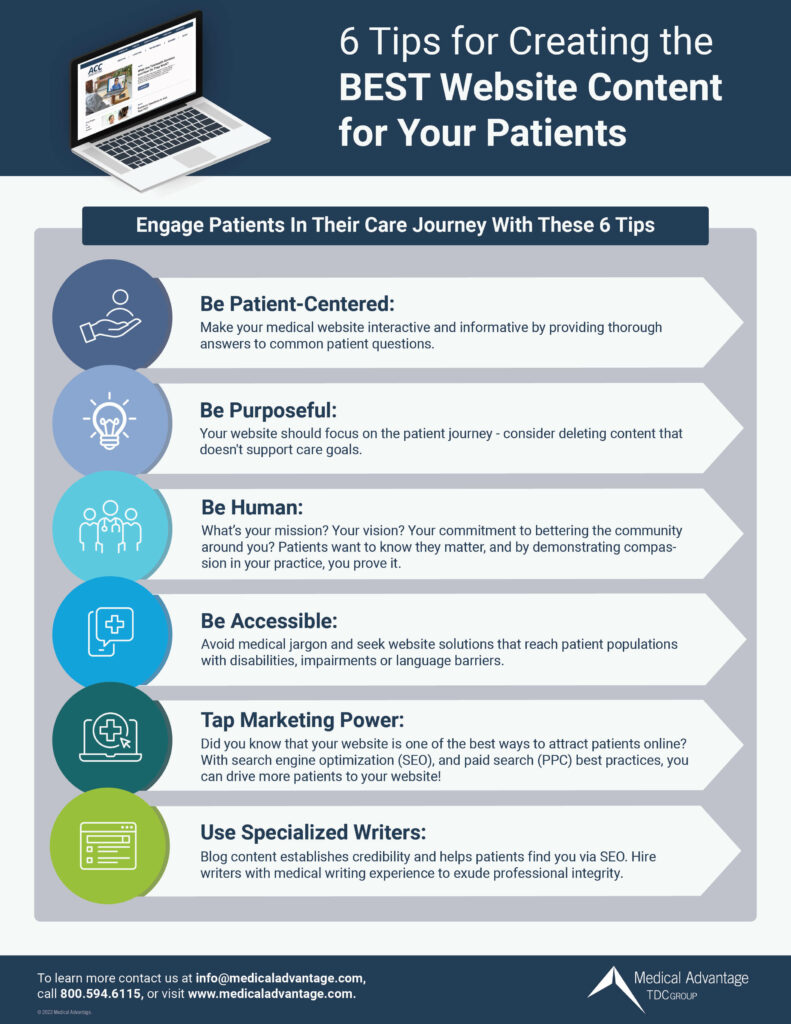Have you ever come across a blog that seemed to fully answer your question? Did it even address the peripheral questions that you had not even searched for yet? Knowing how to write content for a website can be approached from more than one angle, but what we know for sure is that the best medical content online is thoughtful, intuitive, and even empathetic at times.
We go to Google, Siri, or Alexa with our daily questions, but sometimes we need more than a quick answer, and that’s where blog content comes in. A blog’s content format gives you in-depth explanations and detailed information so that you can make informed decisions from day to day.
Writing The Best Content For Your Website
While many variables are at play when coordinating content for your website, the main thing to focus on is relevance. Every part of your website, from your “About Us” section to your latest blog, should be about helping patients along their care journey. The medical writer for your practice may be knowledgeable about many topics, but it is important that they not trail off into other areas that may not be relevant to your patients.
Some content may fall outside the scope of interest of a patient, such as a press release about merging with another practice, but as long as the bulk of the content is patient-centered, and intended to help patients make medical decisions, your website will be in great shape. Take the time to evaluate the content on your website and the purpose that each piece serves. If it is not helping patients or helping the business operations of the practice, it may not belong on the website in the first place.
“Medical website content should be about helping patients along in their care journey.”
How Do I Start Writing Website Content?
Writing website content begins with planning. Having a clear purpose for what each piece of content will do helps direct the process. Good website content should be informationally complete overall, but also effective at helping the patient through their care journey piece by piece.
As they review each page of your website, your patient is getting to know your practice, so thoughtful planning should go into how to write content for a website. It begins with the core content on your website (what is also referred to as website copy). This covers all the sections of your website, such as your “About Us” section, treatment information, services, testimonials, etc. Ideally, each web page should support your practice’s mission and the patient journey.
But having all your pages complete doesn’t mean you are done producing content for the website. Blog content is necessary to build up patient resources while it also helps your practice website to be found in search. Google favors websites that produce regular blog content and stay updated.
Provide Relevant Information
While there are digital marketing tools out there that will tell you what search terms are most popular, it helps to study your own patient population to gain perspective. What questions do you hear most often? When patients come to you with anxiety and trepidation, what are they often worried about? What are some recent discoveries you tell your patients about that other patients may not know about yet?
Because you know your patient base the best, you can use a patient population assessment as a compass to write content for a website. You might also consider adding a frequently asked questions (FAQ) section for patients who want quick answers rather than poring through blogs.
Having a patient-centered website means considering the specific needs of your patient population. The more you hone in on their information needs, the more meaningful your content will be to them.
Be Inclusive
You may care for patients who speak other languages or have impairments. Accommodating communication gaps is inclusivity in action. Solutions to consider are:
- Add an ADA-accessibility tool to your website that allows site visitors with impairments to enjoy the content your website has to offer.
- Consider what other languages are commonly spoken within your community. For example, if you see several patients who speak Spanish, having website content in Spanish will accommodate the patient journey for those who do not speak English as their first language.
Avoid Jargon and Other Terms Your Patients May Not Understand
Yes, you want to have crisp and professional content on your website to maintain credibility, but writing content for a website that is accessible means writing content that can be easily understood by the average reader. Think about how you would communicate information to the patient over the phone, in the office, or on a video call. The language used should be natural and easy for the patient to understand.
If you feel your patients are hungry to learn some of the more complex aspects of your area of healthcare, just be sure to translate terms and jargon that they may be unfamiliar with into plain language. They will be delighted to learn something new from content they can understand.
Keep Language Friendly and Actionable
With a goal to encourage engagement with your practice, providing content that is compassionate, reassuring, validating, and inspiring can help persuade the patient to take important steps in their care journey. Many patients who are reading through pages of web content online are fearful or preoccupied with their health concerns. Content that shows a deep understanding of what they are going through can help put them at ease, but you also want to encourage them to seek the care that they need. Create content that is both considerate of their circumstances, but also encourages them to take action and come to your practice for treatment.
Hire Competent Writers and Editors
Most practices do not have the time for website content creation, either the core web copy or the ongoing blog production. For that reason, practices will outsource their content writing. However, not all website copy or blog writers are fit to produce content for your patients. It would be a waste of resources if you ended up with content you cannot use on your website, so it pays to ensure that you hire people who are up for the task. It is best to work with writers and editors who have a background in medical writing and know how to write content for a website in terms of best practices.

Optimizing Your Content for Search Engines
Aside from impressing your audience with expertise, medical website blog content also has a direct impact on how often your practice shows up online. Producing content that is most relevant to your ideal patient often overlaps with natural search terms your ideal patient is likely entering into search engines. Google can tell when a website is making a concerted effort to produce quality content on a regular basis to best serve website visitors.
Do Your Research – Keyword Research!
One powerful way to strengthen your online presence is with a thoughtful keyword strategy. There are keyword research tools available to identify the best keywords for your website, and these tools are usually utilized by marketing specialists who are hired to manage website content.
Keyword inclusion is paramount when learning how to write content for a website. First, the website content should clearly indicate what kind of practice it is, what geographic areas it covers, and any particulars regarding the patient population served. Next, blog content should focus on topics relevant to the prospective patient and include popular search terms relevant to the topic so that content has the best chance of showing up on search engines.
Google is constantly scanning the internet and indexing each website for what it contains so it can determine which user search terms the content is relevant to. Having quality content rich with keywords relevant to patients in your area best positions your website to be found online by prospects.
Use Internal Linking to Navigate Users Through Your Website
Linking content to other related content (such as site pages, landing pages, and blog articles) helps Google better understand the relevance of each piece. If you can get other websites to link to your content, that is a great help toward building digital authority for your website – and driving more traffic to your site.
Those who read your content will appreciate that you have linked to other content they may be interested in. Linking encourages engagement by providing an information-hungry site visitor given more items to consume.
Using Good “Technical SEO Hygiene”
Because SEO is an integral part of your content strategy, peripheral website elements also contribute to high-performing websites.
- Alternative-text (Alt-text) for images: What is in your images? Alt-text or descriptions of images help Google better understand the visual content.
- Formatting: Web content follows a formatting standard involving headers and tags.
- Sitemap: Having all your content organized into a sitemap also helps Google get an accurate assessment of your website.
- Document changes: When you have made improvements to your site, you should get credit for it. Submitting updated content to Google for indexing helps Google recognize these key updates.
This may all sound foreign to you, and that is okay. Those experienced in SEO digital marketing can help get everything set up the right way for your site to go the distance toward reaching patients online.
Medical Advantage is Your Go-To for Complete Medical Practice Website Services
Creating a content plan can be difficult to navigate and finding the right people to create content also takes away from practice resources. Our medical practice marketing solution not only sets up hosting and builds your website for you, but our content marketing specialists also know how to plan out content that builds your authority and engages patients. From blogs to provider bios, we have it covered page-by-page with creators who know how to write website content that is effective in engaging your target audience – increasing patient volume and patient engagement.
SEO and PPC (pay-per-click) services are also performed by our team to ensure that your website is not just ready for visitors, but also attracts patients. Our goal is to grow your practice by increasing website traffic and attracting the right patients – this all begins with having the best website content. Contact us for a no-obligation consultation to learn more about how to make your website a high-performing practice growth machine.



